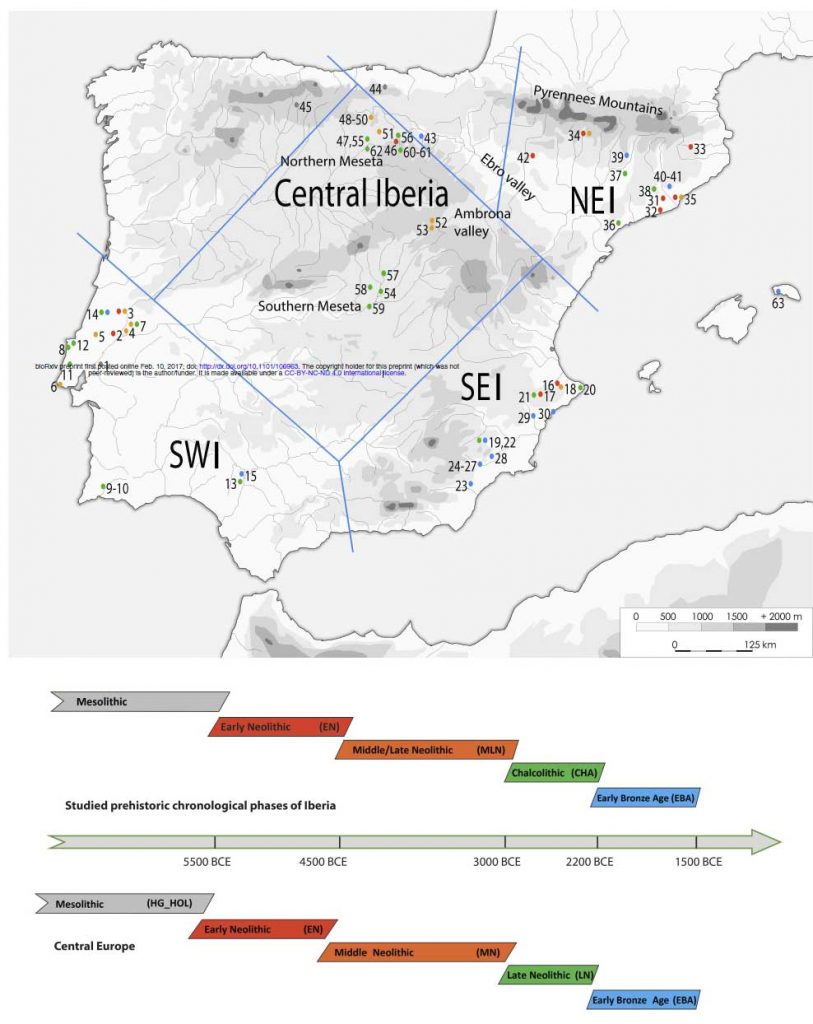A new preprint paper at BioRxiv, The maternal genetic make-up of the Iberian Peninsula between the Neolithic and the Early Bronze Age, by Szécsényi-Nagy et al. (2017).
Abstract:
Agriculture first reached the Iberian Peninsula around 5700 BCE. However, little is known about the genetic structure and changes of prehistoric populations in different geographic areas of Iberia. In our study, we focused on the maternal genetic makeup of the Neolithic (~ 5500-3000 BCE), Chalcolithic (~ 3000-2200 BCE) and Early Bronze Age (~ 2200-1500 BCE). We report ancient mitochondrial DNA results of 213 individuals (151 HVS-I sequences) from the northeast, central, southeast and southwest regions and thus on the largest archaeogenetic dataset from the Peninsula to date. Similar to other parts of Europe, we observe a discontinuity between hunter-gatherers and the first farmers of the Neolithic. During the subsequent periods, we detect regional continuity of Early Neolithic lineages across Iberia, however the genetic contribution of hunter-gatherers is generally higher than in other parts of Europe and varies regionally. In contrast to ancient DNA findings from Central Europe, we do not observe a major turnover in the mtDNA record of the Iberian Late Chalcolithic and Early Bronze Age, suggesting that the population history of the Iberian Peninsula is distinct in character.

Detailed conclusions of their work,
The present study, based on 213 new and 125 published mtDNA data of prehistoric Iberian individuals suggests a more complex mode of interaction between local hunter-gatherers and incoming early farmers during the Early and Middle Neolithic of the Iberian Peninsula, as compared to Central Europe. A characteristic of Iberian population dynamics is the proportion of autochthonous hunter-gatherer haplogroups, which increased in relation to the distance to the Mediterranean coast. In contrast, the early farmers in Central Europe showed comparatively little admixture of contemporaneous hunter-gatherer groups. Already during the first centuries of Neolithic transition in Iberia, we observe a mix of female DNA lineages of different origins. Earlier hunter-gatherer haplogroups were found together with a variety of new lineages, which ultimately derive from Near Eastern farming groups. On the other hand, some early Neolithic sites in northeast Iberia, especially the early group from the cave site of Els Trocs in the central Pyrenees, seem to exhibit affinities to Central European LBK communities. The diversity of female lineages in the Iberian communities continued even during the Chalcolithic, when populations became more homogeneous, indicating higher mobility and admixture across different geographic regions. Even though the sample size available for Early Bronze Age populations is still limited, especially with regards to El Argar groups, we observe no significant changes to the mitochondrial DNA pool until the end of our time transect (1500 BCE). The expansion of groups from the eastern steppe, which profoundly impacted Late Neolithic and EBA groups of Central and North Europe, cannot (yet) be seen in the contemporaneous population substrate of the Iberian Peninsula at the present level of genetic resolution. This highlights the distinct character of the Neolithic transition both in the Iberian Peninsula and elsewhere and emphasizes the need for further in depth archaeogenetic studies for reconstructing the close reciprocal relationship of genetic and cultural processes on the population level.
So it seems more and more likely that the North-West Indo-European invasion during the Copper Age (signaled by changes in Y-DNA lineages) was not, as in central Europe, accompanied by much mtDNA turnover. What that means – either a male-dominated invasion, or a longer internal evolution of invasive Y-DNA subclades – remains to bee seen, but I am still more inclined to see the former as the most likely interpretation, in spite of admixture results.
Related:
- Analysis of R1b-DF27 haplogroups in modern populations adds new information that contrasts with ‘steppe admixture’ results
- Neolithic and Bronze Age Basque-speaking Iberians resisted invaders from the steppe
- Something is very wrong with models based on the so-called ‘steppe admixture’ – and archaeologists are catching up
- How to do modern phylogeography: Relationships between clans and genetic kin explain cultural similarities over vast distances
- Heyd, Mallory, and Prescott were right about Bell Beakers
Featured images: from the article, licensed BY-NC-ND.